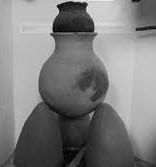
Igikoro bamwe bita ikinyamayogi ni kimwe mu binyabijumba abantu benshi badakunze kwitabira kurya, nyamara gifite akamaro kanini ku buzima bw’umuntu.
Ubushakashatsi bwasohotse mu kinyamakuru “Food chemistry” bwerekanye ko igikoro ari isoko ya “fibres alimentaire”, vitamini nka C, B1 na B6; ndetse n’imyunyungugu nka potasiyumu na manganese, kikaba kandi gikungahaye kuri poroteyini.
Uwariye igikoro ahorana imbaraga kubera ziriya “fibres alimentaires” zibamo. Ubushakashatsi bwasohotse mu kinyamakuru “Medicinal Food” bwerekanye ko mu bigize igikoro harimo n’ibirinda umubiri kwangirika, bikagabanya “steress” kandi kikarinda umuntu kwibasirwa n’indwara zidakira nk’iz’umutima na kanseri. Ubu bushakashatsi kandi bwagaragaje uruhare rw’igikoro mu kuringaniza isukari mu maraso.

Mbese mu Rwanda iki gihingwa kiracyaribwa?
Mu bukangurambaga bwiswe “Mpisemo ibiryo Nyafurika” ACORD-Rwanda irashishikariza abanyarwanda gukunda ibiryo gakondo birimo ibikoro, amateke, imyumbati, ibihaza n’ibindi.
Nk’uko bigaragazwa na ACORD-Rwanda, kuri ubu Abanyarwanda cyane cyane abakiri bato ntibagikunda kurya ibiryo bita ngo bya kinyarwanda, ahubwo ugasanga bibanda ku byo bita “fast food” ni ukuvuga byose byongerwamo imiti ituma bimara igihe ikongera uburyohe, ariko iyi miti ibangamira umwimerere w’ibiryo ndetse ishobora no kwangiza ubuzima bw’umuntu.
Uburyo igikoro gitegurwa

Igikoro gitekwa nk’ibindi binyabijumba byose. Ushobora kugitogosa mu mazi gusa, ushobora no kugiteka ukigeretse ku bishyimbo.
Mu bushakashatsi bwakozwe na ACORD-Rwanda bavuga ko ibiryo gakondo by’u Rwanda harimo n’ibikoro, byatekwaga mu nkono imwe habanje ibitinda gushya, hakagerekwaho ibindi byose bikenewe kugira ngo bikore ibiryo byiza, biryoshye, byujuje intungamubiri za ngombwa.
Ibikoro bifite inkomoko muri Afurika y’uburengerazuba, ariko kugeza ubu bimaze gukwira henshi muri Afurika ndetse no mu Rwanda.




Urakoze cyane rwose, nibazaga umumaro wacyo none nsubijwe vuba ntavunitse. Komeza utugezeho ibidufitiye akamaro rwose
Namwe murakoze